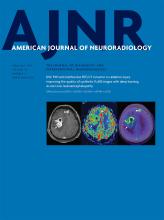Research ArticlePediatric Neuroimaging
Open Access
Cavum Septum Pellucidum in the General Pediatric Population and Its Relation to Surrounding Brain Structure Volumes, Cognitive Function, and Emotional or Behavioral Problems
M.H.G. Dremmen, R.H. Bouhuis, L.M.E. Blanken, R.L. Muetzel, M.W. Vernooij, H.E. Marroun, V.W.V. Jaddoe, F.C. Verhulst, H. Tiemeier and T. White
American Journal of Neuroradiology February 2019, 40 (2) 340-346; DOI: https://doi.org/10.3174/ajnr.A5939
M.H.G. Dremmen
aFrom the Departments of Radiology (M.H.G.D., R.H.B., M.W.V., T.W.)
R.H. Bouhuis
aFrom the Departments of Radiology (M.H.G.D., R.H.B., M.W.V., T.W.)
L.M.E. Blanken
dDepartment of Child and Adolescent Psychiatry (L.M.E.B., R.L.M., H.E.M., F.C.V., H.T., T.W.)
eGeneration R Study Group (L.M.E.B., R.L.M., H.E.M.), Erasmus Medical Center-Sophia, Rotterdam, the Netherlands
R.L. Muetzel
bEpidemiology (R.L.M., M.W.V., V.W.V.J.)
dDepartment of Child and Adolescent Psychiatry (L.M.E.B., R.L.M., H.E.M., F.C.V., H.T., T.W.)
eGeneration R Study Group (L.M.E.B., R.L.M., H.E.M.), Erasmus Medical Center-Sophia, Rotterdam, the Netherlands
M.W. Vernooij
aFrom the Departments of Radiology (M.H.G.D., R.H.B., M.W.V., T.W.)
bEpidemiology (R.L.M., M.W.V., V.W.V.J.)
H.E. Marroun
dDepartment of Child and Adolescent Psychiatry (L.M.E.B., R.L.M., H.E.M., F.C.V., H.T., T.W.)
eGeneration R Study Group (L.M.E.B., R.L.M., H.E.M.), Erasmus Medical Center-Sophia, Rotterdam, the Netherlands
V.W.V. Jaddoe
bEpidemiology (R.L.M., M.W.V., V.W.V.J.)
cPediatrics (V.W.V.J.), Erasmus Medical Center, Rotterdam, the Netherlands
F.C. Verhulst
dDepartment of Child and Adolescent Psychiatry (L.M.E.B., R.L.M., H.E.M., F.C.V., H.T., T.W.)
fDepartment of Clinical Medicine (F.C.V.), University of Copenhagen, Copenhagen, Denmark
H. Tiemeier
dDepartment of Child and Adolescent Psychiatry (L.M.E.B., R.L.M., H.E.M., F.C.V., H.T., T.W.)
gHarvard School of Public Health (H.T.), Boston, Massachusetts.
T. White
aFrom the Departments of Radiology (M.H.G.D., R.H.B., M.W.V., T.W.)
dDepartment of Child and Adolescent Psychiatry (L.M.E.B., R.L.M., H.E.M., F.C.V., H.T., T.W.)

References
- 1.↵
- Sarwar M
- 2.↵
- Dickey CC,
- McCarley RW,
- Xu ML, et al
- 3.↵
- Choi JS,
- Kang DH,
- Park JY, et al
- 4.↵
- Shunk H
- 5.↵
- Nopoulos PC,
- Giedd JN,
- Andreasen NC, et al
- 6.↵
- 7.↵
- Rajarethinam R,
- Miedler J,
- DeQuardo J, et al
- 8.↵
- 9.↵
- de Souza Crippa JA,
- Zuardi AW,
- Busatto GF, et al
- 10.↵
- Flashman LA,
- Roth RM,
- Pixley HS, et al
- 11.↵
- 12.↵
- 13.↵
- 14.↵
- 15.↵
- Raine A,
- Lee L,
- Yang Y, et al
- 16.↵
- 17.↵
- 18.↵
- Kasai K,
- McCarley RW,
- Salisbury DF, et al
- 19.↵
- 20.↵
- 21.↵
- 22.↵
- Nopoulos P,
- Berg S,
- Castellenos FX, et al
- 23.↵
- 24.↵
- Bodensteiner JB,
- Schaefer GB,
- Craft JM
- 25.↵
- Swayze VW 2nd.,
- Johnson VP,
- Hansen JW, et al
- 26.↵
- Renier D,
- Arnaud E,
- Cinalli G, et al
- 27.↵
- Jaddoe VW,
- Mackenbach JP,
- Moll HA, et al
- 28.↵
- 29.↵
- 30.↵
- 31.↵
- 32.↵
- Fischl B,
- Salat DH,
- Busa E, et al
- 33.↵
- Achenbach TM,
- Rescorla LA
- 34.↵
- 35.↵
- Moore C,
- O'Keefe S,
- Lawhorn D, et al., et al
- 36.↵
- Snijders JH,
- Snijders-Oomen AW,
- Tellegen PJ, et al
- 37.↵
- 38.↵
- 39.↵
- Lee JK,
- Wu J,
- Banks S, et al
- 40.↵
- 41.
- El Marroun H,
- White TJ,
- van der Knaap NJ, et al
In this issue
American Journal of Neuroradiology
Vol. 40, Issue 2
1 Feb 2019
Advertisement
M.H.G. Dremmen, R.H. Bouhuis, L.M.E. Blanken, R.L. Muetzel, M.W. Vernooij, H.E. Marroun, V.W.V. Jaddoe, F.C. Verhulst, H. Tiemeier, T. White
Cavum Septum Pellucidum in the General Pediatric Population and Its Relation to Surrounding Brain Structure Volumes, Cognitive Function, and Emotional or Behavioral Problems
American Journal of Neuroradiology Feb 2019, 40 (2) 340-346; DOI: 10.3174/ajnr.A5939
0 Responses
Cavum Septum Pellucidum in the General Pediatric Population and Its Relation to Surrounding Brain Structure Volumes, Cognitive Function, and Emotional or Behavioral Problems
M.H.G. Dremmen, R.H. Bouhuis, L.M.E. Blanken, R.L. Muetzel, M.W. Vernooij, H.E. Marroun, V.W.V. Jaddoe, F.C. Verhulst, H. Tiemeier, T. White
American Journal of Neuroradiology Feb 2019, 40 (2) 340-346; DOI: 10.3174/ajnr.A5939
Jump to section
Related Articles
Cited By...
This article has not yet been cited by articles in journals that are participating in Crossref Cited-by Linking.
More in this TOC Section
Similar Articles
Advertisement











